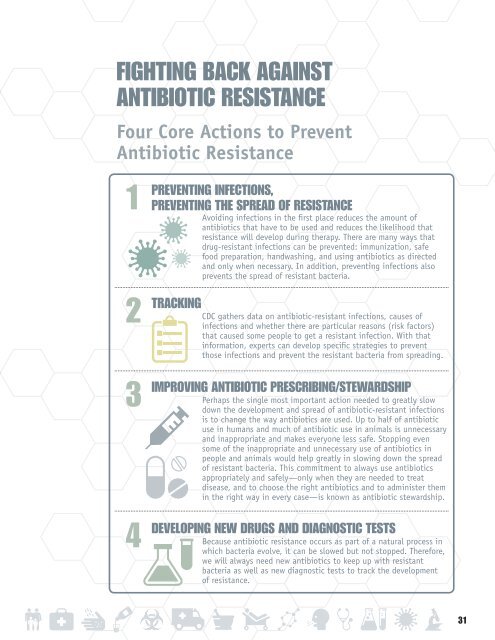Antibiotic Resistance Threats in the United States, 2013 report
Antibiotic Resistance Threats in the United States, 2013 report
Antibiotic Resistance Threats in the United States, 2013 report
You also want an ePaper? Increase the reach of your titles
YUMPU automatically turns print PDFs into web optimized ePapers that Google loves.
FIGHTING BACK AGAINST<br />
ANTIBIOTIC RESISTANCE<br />
Four Core Actions to Prevent<br />
<strong>Antibiotic</strong> <strong>Resistance</strong><br />
1<br />
2<br />
PREVENTING INFECTIONS,<br />
PREVENTING THE SPREAD OF RESISTANCE<br />
Avoid<strong>in</strong>g <strong>in</strong>fections <strong>in</strong> <strong>the</strong> first place reduces <strong>the</strong> amount of<br />
antibiotics that have to be used and reduces <strong>the</strong> likelihood that<br />
resistance will develop dur<strong>in</strong>g <strong>the</strong>rapy. There are many ways that<br />
drug-resistant <strong>in</strong>fections can be prevented: immunization, safe<br />
food preparation, handwash<strong>in</strong>g, and us<strong>in</strong>g antibiotics as directed<br />
and only when necessary. In addition, prevent<strong>in</strong>g <strong>in</strong>fections also<br />
prevents <strong>the</strong> spread of resistant bacteria.<br />
TRACKING<br />
CDC ga<strong>the</strong>rs data on antibiotic-resistant <strong>in</strong>fections, causes of<br />
<strong>in</strong>fections and whe<strong>the</strong>r <strong>the</strong>re are particular reasons (risk factors)<br />
that caused some people to get a resistant <strong>in</strong>fection. With that<br />
<strong>in</strong>formation, experts can develop specific strategies to prevent<br />
those <strong>in</strong>fections and prevent <strong>the</strong> resistant bacteria from spread<strong>in</strong>g.<br />
3<br />
4<br />
IMPROVING ANTIBIOTIC PRESCRIBING/STEWARDSHIP<br />
Perhaps <strong>the</strong> s<strong>in</strong>gle most important action needed to greatly slow<br />
down <strong>the</strong> development and spread of antibiotic-resistant <strong>in</strong>fections<br />
is to change <strong>the</strong> way antibiotics are used. Up to half of antibiotic<br />
use <strong>in</strong> humans and much of antibiotic use <strong>in</strong> animals is unnecessary<br />
and <strong>in</strong>appropriate and makes everyone less safe. Stopp<strong>in</strong>g even<br />
some of <strong>the</strong> <strong>in</strong>appropriate and unnecessary use of antibiotics <strong>in</strong><br />
people and animals would help greatly <strong>in</strong> slow<strong>in</strong>g down <strong>the</strong> spread<br />
of resistant bacteria. This commitment to always use antibiotics<br />
appropriately and safely—only when <strong>the</strong>y are needed to treat<br />
disease, and to choose <strong>the</strong> right antibiotics and to adm<strong>in</strong>ister <strong>the</strong>m<br />
<strong>in</strong> <strong>the</strong> right way <strong>in</strong> every case—is known as antibiotic stewardship.<br />
DEVELOPING NEW DRUGS AND DIAGNOSTIC TESTS<br />
Because antibiotic resistance occurs as part of a natural process <strong>in</strong><br />
which bacteria evolve, it can be slowed but not stopped. Therefore,<br />
we will always need new antibiotics to keep up with resistant<br />
bacteria as well as new diagnostic tests to track <strong>the</strong> development<br />
of resistance.<br />
31
















